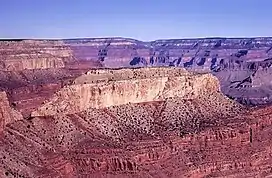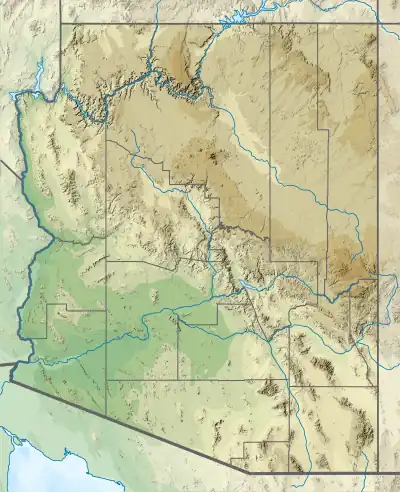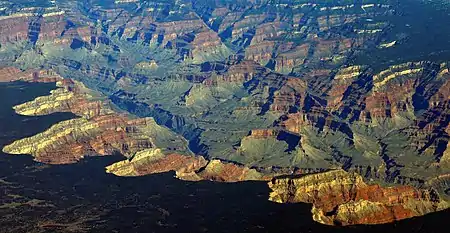Castor Temple
Castor is a 6,221-foot-elevation (1,896-meter) summit located in the Grand Canyon, in Coconino County of northern Arizona, United States.[3] It is situated 11 miles west-northwest of Grand Canyon Village, and less than one mile north of Piute Point. Pollux Temple is one mile southeast, and Geikie Peak is three miles to the east. Topographic relief is significant as Castor Temple rises over 3,800 feet (1,200 meters) above the Colorado River in two miles.
| Castor Temple | |
|---|---|
 Southeast aspect, from Jicarilla Point | |
| Highest point | |
| Elevation | 6,221 ft (1,896 m)[1] |
| Prominence | 581 ft (177 m)[1] |
| Parent peak | Pollux Temple (6,251 ft)[2] |
| Isolation | 1.07 mi (1.72 km)[2] |
| Coordinates | 36°07′44″N 112°19′07″W[3] |
| Geography | |
 Castor Temple Location in Arizona  Castor Temple Castor Temple (the United States) | |
| Location | Grand Canyon National Park Coconino County, Arizona, US |
| Parent range | Coconino Plateau Colorado Plateau |
| Topo map | USGS Havasupai Point |
| Geology | |
| Type of rock | limestone, sandstone, mudstone |
| Climbing | |
| First ascent | 1971 |
| Easiest route | class 4 climbing[2] |
Castor Temple is named for Castor, the twin half-brother of Pollux according to Greek mythology.[4] In ancient Rome, the Temple of Castor and Pollux was in close proximity to the Temple of Vesta, and in the Grand Canyon, Vesta Temple is situated less than four miles to the southeast.[5] Clarence Dutton began the tradition of naming geographical features in the Grand Canyon after mythological deities.[6] This geographical feature's name was officially adopted in 1964 by the U.S. Board on Geographic Names.[3]
According to the Köppen climate classification system, Castor Temple is located in a Cold semi-arid climate zone.[7] Access to this feature is via the Tonto Trail, and the first ascent of the summit was made April 19, 1971, by Donald Davis and Alan Doty.[8]
Geology
Castor Temple is capped by a thin ledge with trees, the Brady Canyon Member of the Permian Toroweap Formation, which overlies the Seligman Member, also Toroweap. Below is conspicuous, cream-colored, cliff-former Coconino Sandstone, which is the third-youngest of the strata in the Grand Canyon, and was deposited 265 million years ago as sand dunes. The Coconino overlays Permian Hermit Formation (reddish slope), Esplanade Sandstone (red ledges), and Wescogame and Manakacha Formations of the Pennsylvanian-Permian Supai Group.[9][10] Further down are strata of the cliff-forming Mississippian Redwall Limestone, and finally the Cambrian Tonto Group. Precipitation runoff from Castor Temple drains northeast to the Colorado River via Turquoise and Sapphire Canyons.
References
- "Castor Temple, Arizona". Peakbagger.com. Retrieved 2021-02-01.
- "Castor Temple – 6,221' AZ". Lists of John. Retrieved 2021-02-01.
- "Castor Temple". Geographic Names Information System. United States Geological Survey, United States Department of the Interior. Retrieved 2021-02-01.
- N.H. Darton, Story of the Grand Canyon of Arizona, 1917, page 77.
- Gregory McNamee, Grand Canyon Place Names, 1997, Mountaineers, page 33.
- Randy Moore and Kara Felicia Witt, The Grand Canyon: An Encyclopedia of Geography, History, and Culture, 2018, ABC-CLIO Publisher, page 151.
- Peel, M. C.; Finlayson, B. L.; McMahon, T. A. (2007). "Updated world map of the Köppen−Geiger climate classification". Hydrol. Earth Syst. Sci. 11. ISSN 1027-5606.
- Todd R. Berger, Reflections of Grand Canyon Historians: Ideas, Arguments and First-Person Accounts, 2nd edition, 2008, Grand Canyon Association Publisher, ISBN 978-1934656006, page 197.
- William Kenneth Hamblin, Anatomy of the Grand Canyon: Panoramas of the Canyon's Geology, 2008, Grand Canyon Association Publisher, ISBN 9781934656013.
- N.H. Darton, Story of the Grand Canyon of Arizona, 1917.

External links
- Weather forecast: National Weather Service
- Castor Temple photo from Piute Point